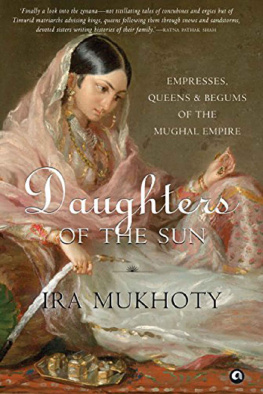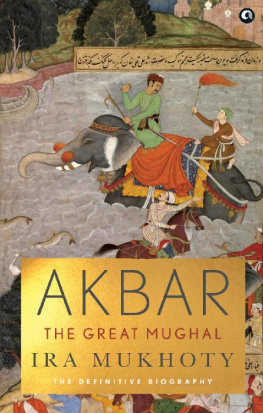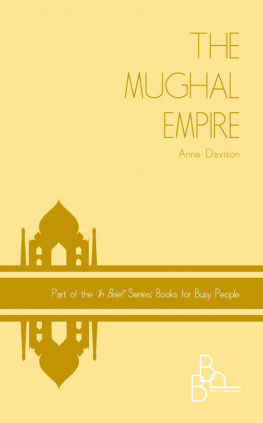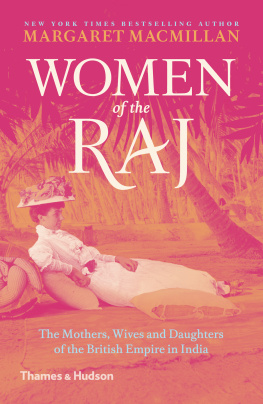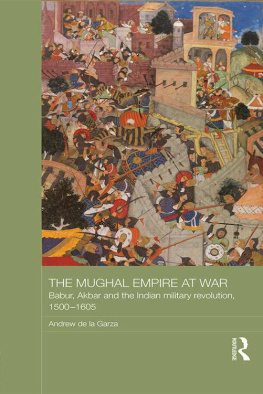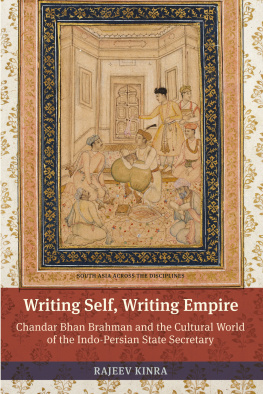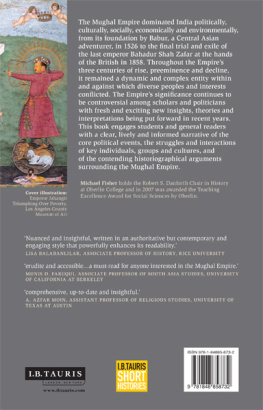
Also by Ira Mukhoty
Heroines: Powerful Indian Women of Myth and History


ALEPH BOOK COMPANY
An independent publishing firm promoted by Rupa Publications India
First published in India in 2018
by Aleph Book Company
7/16 Ansari Road, Daryaganj
New Delhi 110 002
Copyright Ira Mukhoty 2018
Pages 249 to 250 (Image Credits) are an extension of the copyright page
All rights reserved.
The author has asserted her moral rights.
The views and opinions expressed in this book are the authors own and the facts are as reported by her, which have been verified to the extent possible, and the publishers are in no way liable for the same.
No part of this publication may be reproduced, transmitted, or stored in a retrieval system, in any form or by any means, without permission in writing from Aleph Book Company.
ISBN: 978-93-86021-12-0
1 3 5 7 9 10 8 6 4 2
This book is sold subject to the condition that it shall not, by way of trade or otherwise, be lent, resold, hired out, or otherwise circulated without the publishers prior consent in any form of binding or cover other than that in which it is published
To the memory of my parents,
Gobind and Nicolle Mukhoty
CONTENTS
INTRODUCTION
India was ruled for over 200 years by the Gurkani, a clan that established an empire of such magnificence, size and wealth, that it became a byword for glory around the world. But the name by which the Gurkani became rightly famous was an aberration. The dynasty was a nomadic Timurid one, as the founder, Babur, proudly traced his lineage directly to the Turkic conqueror Amir Timur (also known as Tamerlane), who established an empire in the fourteenth century quite as glorious as Chinghiz Khans. Babur referred to himself, and to his lineage, as Gurkani, from the Persianized Mongol word for guregen, or son-in-law, since some of the Timurids, including Amir Timur himself, had married Chingizid women, to add to their legitimacy. But Babur himself, and all of his descendants, male and female, were intensely proud of their Timurid lineage, very consciously evoking the Timurid charisma in various ways. Indeed, Babur thoroughly loathed his Mongol cousins, the Uzbeks, considering them brutish and uncivilized, and would have been horrified to know that his dynasty would become synonymous with an Anglicized form of Mongolsthe Mughals of India.
It was while researching my first book, Heroines, that I realized the casual negligence with which we regard our history in India and the sometimes benign largesse with which we assimilate inaccuracy and fallacy as received wisdom. But the naming of things is important. It shapes the way in which we view ourselves and the place we occupy in the world. To name a thing is to magic it into being, to give it substance and weight. When the Europeans gave the name Mughals to Baburs dynasty, they were negligently assuming a shared Mongol inheritance for all Central Asian conquerors. One of the women I studied for my collection of essays in Heroines was Jahanara Begum, among the most accomplished women of the Mughal empire. I discovered the exact depth of my ignorance at that pointan ignorance that was also inadvertently tainted with prejudice.
The misnomer of the dynasty is only the very beginning of an enormous amount of almost whimsical misinformation that surrounds the history of the Mughals. The empire of the great Mughalsfrom Baburs invasion at Panipat in 1526 to the death of Aurangzeb in 1707coincides exactly with the arrival and settling of the Europeans in India for trade and more, the elucidation of that history and the way in which we view it even today is marked by the way in which those early Europeans experienced and interpreted Mughal rule. The Europeans kept meticulous records of all their transactions with the Mughal court. They wrote detailed accounts in their letters to their holding companies and they wrote memoirs and travelogues. Jesuit missionaries arrived at the same time and they too wrote extensively of their experiences and travels. On the other hand, from the Indian point of view, it was considered indelicate, indeed outright rude, to write about royal Muslim women who were expected to maintain a decorous purdah. The Europeans, not held back by any such need for decorum, were instead fascinated by the notion of the private space of the Mughal women and indulged in some truly fervid leaps of imagination when trying to conjure up that forbidden worldthe Mughal harem.
An Englishman travelling to Mecca in the seventeenth century admitted that the first question a traveller returning from the East was faced with was what are the women like? And yet, when European men interacted with the Mughal court, they found themselves distanced from the affairs of women at several levels: as men, European men, they were both physically and culturally separated from the world of women. The purdah of the zenana meant that the women and the household that they inhabited were prohibited to them. Franois Bernier, a seventeenth-century French physician and meticulous observer of Shahjahanabad, admitted that though he yearned to visit the zenana, who is the traveller that can describe from ocular observation the interior of the building? Moreover, since they usually did not speak Persian or Turki, Europeans could only comprehend this beguiling world through an interpreter. The nuances of culture and comportment were therefore often inaccessible to them. They could not understand the reason for a Mughal womans influence and power, attributing it to an emperors weakness, or worse, to incest. The resulting chimera creation, the Oriental harem, was therefore a lurid and sometimes fantastical mix of bazaar gossip, stray gleanings of fact and sexual fantasy. The most frequent portrayal of this harem, as it was consumed eagerly by a curious audience in Europe that was beginning to be fascinated by the exotic East, was that of a cruel, despotic and endlessly lascivious emperor surrounded by thousands of nubile young women competing for his attention and pining away in sexual frustration. Not only was this image eagerly adopted by Western audiences, it also trickled down into the Indian consciousness through the colonial experience and the European narrative of Indian history. Thus, to this day, there is a perception that Mughal women operated within a fixed zone of influence, the domestic harem, an immutable cloistered space in which they led restricted and unfulfilled lives, from which they could seldom escape, and to which only the emperor had access. As I discovered while doing my research on the women of the great Mughals, nothing could be farther from the truth. In fact, the zenana was an industrious, carefully calibrated and orchestrated world. The wanton world of the Europeans imagination in which the women ruthlessly schemed against one another and wasted the hours of their days in frustrated languor was just that, a fantasy. The zenana was instead a busy, well-ordered place where each woman knew her place and her worth. It was a place where accomplished, educated women were prized; well-spoken, articulate and cultured women most likely to advance. There were intrigues, and jealousies, certainly, for how would there not be when hundreds and sometimes thousands of people lived together? But the overwhelming nature of the zenana was one of warm support and companionship, a complex, nuanced world of female complicity and understanding, one in which excellence was valued and women learned all the skills required to run a city, for there were no men within.
Next page
